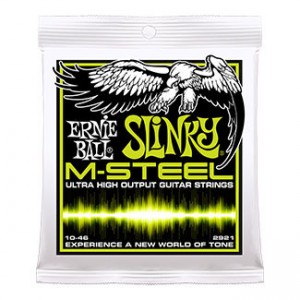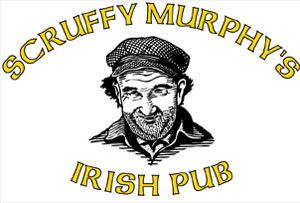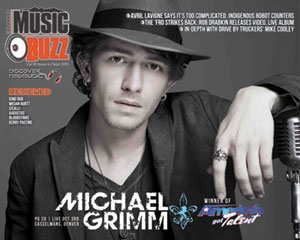Guitar Center Product Reviews: Ernie Ball M Steel Strings
by Stu Wilf
Being a long time fan of Ernie Ball, I was pleased to hear about their new line of ‘M Steel’ strings that were released at the 2014 NAMM show. I have been using the Slinky line for over 10 years without issue, but as of late really wanted to get something totally new and different. These brought just what I was longing for.
What perked my interest in these strings was the material being used. These are constructed with a compound called maraging steel, made up of nickel, cobalt, molybdenum and titanium. This form of “aged” steel is extremely durable while retaining softer metal characteristics. In its non-stainless variety (as these strings are) it is moderately corrosion-resistant, as well as resistive to stress corrosion leaving it a highly durable string. The maraging steel is also where they get their name “M Steel”. This is a very cool and unique material, and you will notice a different look to these strings as soon as you open up the package!
Being mostly nickel, the strings have familiar tone to the rest of the slinky line with a slight twist from the cobalt. The molybdenum and titanium in the alloy are non-magnetic so they do not have an impact on the interference of the magnetism of your pickups, but in the makeup help to allow the strings to resonate in a particular way, adding to the tone. There is a brightness to it that is not found in the classic Slinky line, but with superb undertones adding mellowness to the bite and tying the varying frequencies together.
A hex core allows for increased sustain, attack and resonance. Though there is not a huge difference between round and hex core, have the flat surface area allows for greater impact as the notes are fretted by giving more surface area upon contact. This then directs the transverse waves to the fret in a more direct manner making it become slightly more “connected” to each fret. Doing so give the string opportunity to vibrate further for longer, resulting in your guitar actually sounding louder, without increasing any volume! (I have heard some people say they do not like the feel of a hex core string, but I haven’t been able to tell enough of a difference for it to dissuade me from using them).
TESTING
I tested two sets of 10’s on two different guitars, both through my Vox. The first set I put on my 2005 American Standard Strat. I fitted thisguitar with a brass nut, vintage bridge, original pickups and frets. When I put the strings on, I could hear a pleasant uniqueness about the string that I didn’t expect but seemed to be slightly more tinny than anticipated. Ernie Ball had promoted it as not being overly bright, but the strings sounded a little strong in the highs while I was tuning up (possibly from the molybdenum and titanium). Once plugged into the amp, that was not the case. I had the feel of a brand new string without the tinny sound that typically sneaks into the amp! I tore through a few licks from Misirlou and Purple Haze and didn’t want to stop. The strings felt great and didn’t seem to want to stretch out super fast and kept excellent pitch and intonation.
The second guitar I was on was a custom build that I made, an all mahogany, ebony fingerboard, 25.5” scale 24 fret, neck-thru construction shred machine equipped with a set of Seymour Duncan Blackouts and an original Floyd Rose. It was the same start out on this one as the Strat, without being plugged in sounded tinny, but once the axe was amped up that was gone. I was extremely pleased with the way the stings reacted with the active humbuckers, a perfect marriage of low end aggression with the high end singing clearly. I went straight to the lead channel with this one and busted out some riffs from the Faceless, Pantera, and Origin. These strings held up flawlessly to the hard pounding of metal and the abusive dive bombs with the Floyd Rose. Staying in tune was not an issue after getting the strings a little more stretched.
While these strings sounded great and played nice on both guitars, I believe that the dominant market for M Steel will be in the hard rock and metal community of musicians. These strings are designed for people who play hard and don’t want to have to worry about breaking strings every show while not sacrificing any of their tone.
Online: http://www.guitarcenter.com/Ernie-Ball-M-Steel–g27132t0.gc?esid=M%20Stee
Category: Product Reviews


















